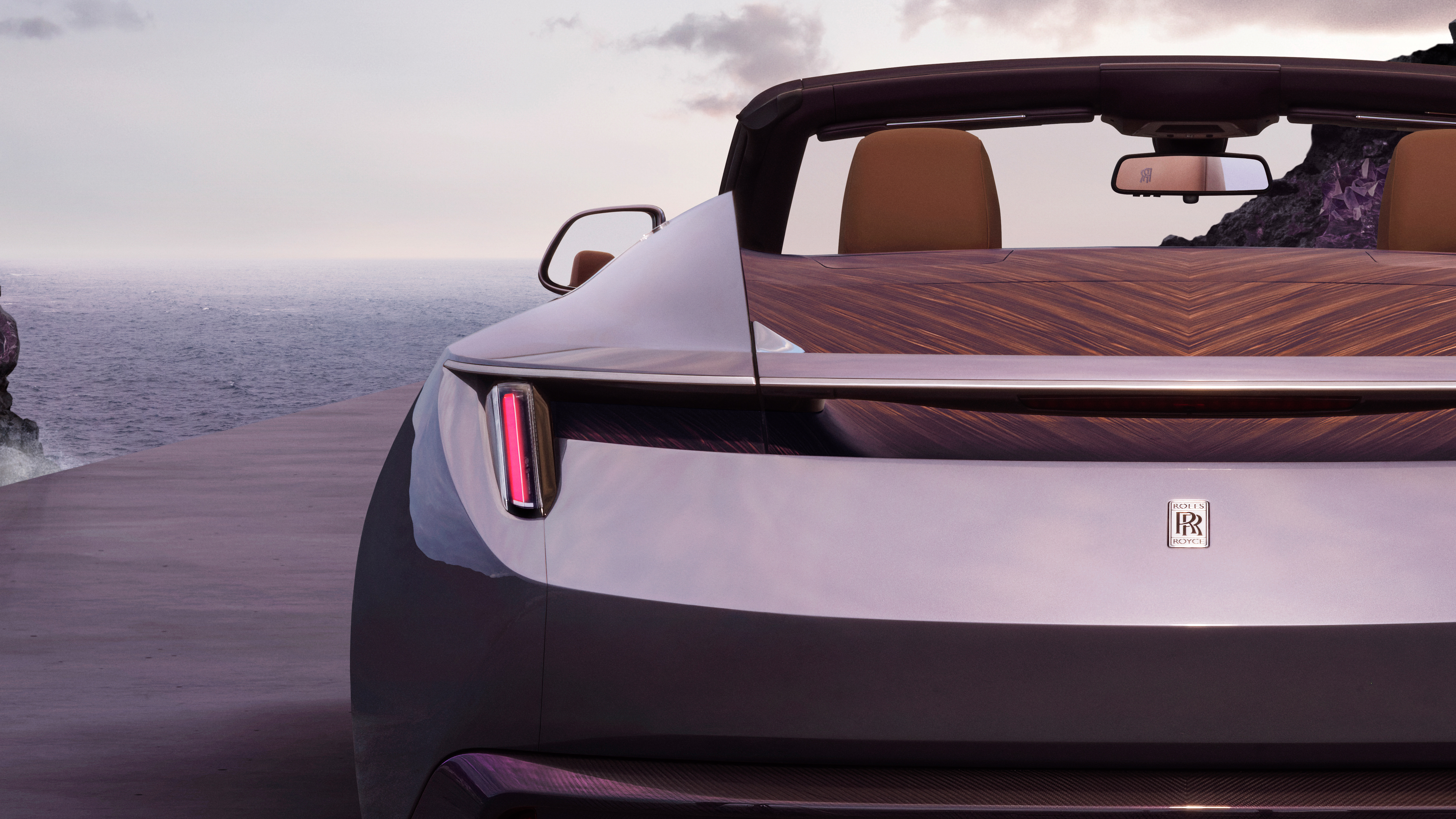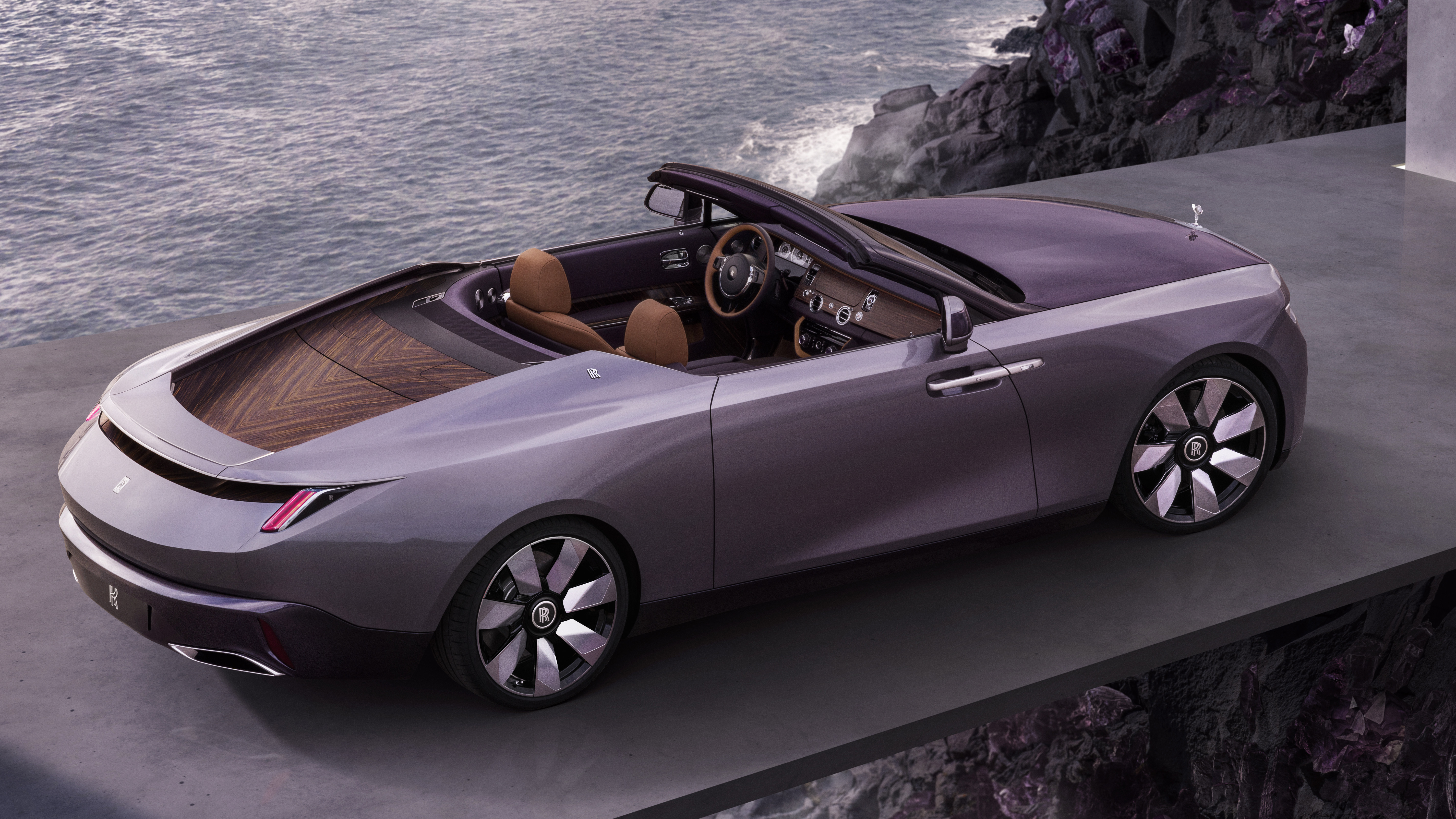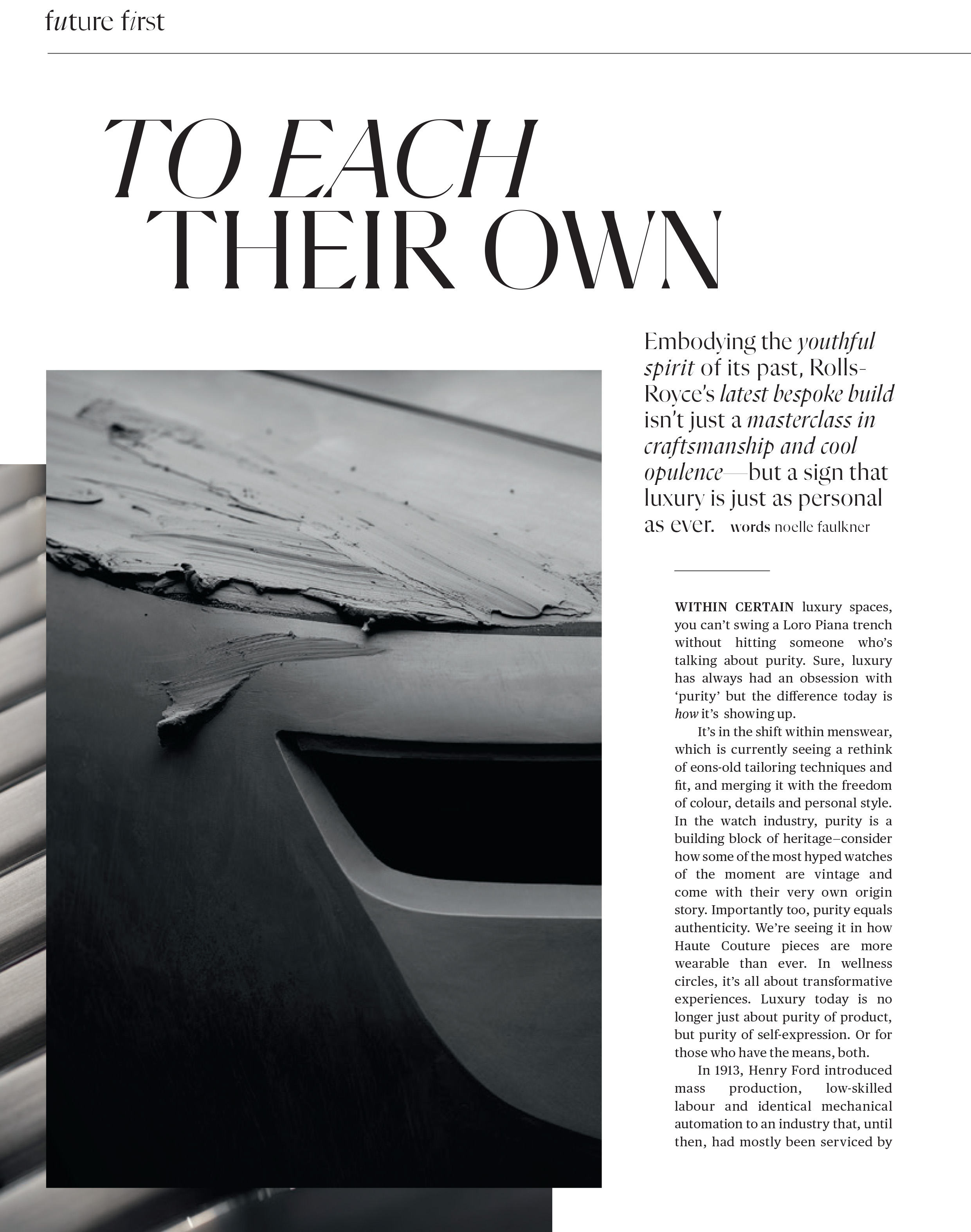TO EACH THEIR OWN:INSIDE ROLLS-ROYCE COACHBUILD

Esquire Australia, November 2023 (PDF)
Embodying the youthful spirit of its past, Rolls-Royce’s latest bespoke build isn’t just a masterclass in craftsmanship and cool opulence—but a sign that luxury is just as personal as ever.
Within certainluxury spaces, you can’t swing a Loro Piana trench without hitting someone who’s talking about purity. Sure, luxury has always had an obsession with ‘purity’ but the difference today is how it’s showing up. It’s in the shift within menswear, which is currently seeing a rethink of eons-old tailoring techniques and fit, and merging it with the freedom of colour, details and personal style. In the watch industry, purity is a building block of heritage—consider how some of the most hyped watches of the moment are vintage and come with their very own origin story. Importantly too, purity equals authenticity. We’re seeing it in how Haute Couture pieces are more wearable than ever. In wellness circles, it’s all about transformative experiences. Luxury today is no longer just about purity of product, but purity of self-expression. Or for those who have the means, both.
In 1913, Henry Ford introduced mass production, low-skilled labour and identical mechanical automation to an industry that, until then, had mostly been serviced by coachbuilders. That is, highly skilled craftsmen who used artisanal techniques to create beautiful, original, and importantly, handmade vehicle bodies for those privileged enough to own a motorcar. While Ford’s innovative rolling assembly line is credited with many great things, including laying the groundwork for the automotive industry today, as mass production became the norm around the world, the art of coachbuilding (which dates back to Roman times, by the way) faded.
Today, only a handful of small-volume carmakers and design houses, such as Bentley, Niels van Roij, Singer, Zagato, and Carrozzeria Touring Superleggera, are keeping the spirit of this artistic practice alive by creating one-off bespoke automotive projects for their patrons. Few, though, are as exclusive, innovative and meticulously detailed as Rolls-Royce’s coachbuild division, which, through the use of meticulous craft techniques, technology and the sheer pursuit of beauty, has taken the hundred-plus-year-old practice t

Meet the Rolls-Royce Droptail. The third project to emerge from the Goodwood-based marque since it revived its coachbuilding program in 2017, the car was four and a half years in the making. Limited to four models, each completely different from its siblings, Droptail is the first two-seater roadster since the Gatsby-era coachbuilt cars of the early 20th century. Its arrival speaks as much to the influence of an increasingly young cohort of Rolls-Royce buyers, as it does to the current desire for usable luxury.
“Droptail is a new definition of a Rolls-Royce,” explains Anders Warming, the company’s director of design. “It is something that we have not seen in modern times because it really is a romantic representation of a roadster, not a car you would normally refer to if you think of a Rolls-Royce. But if you look in the history books, you will find one-off cars like this.”
Warming is referring to a period in the 1920s and early ’30s, where, in a move that ran counter to the desires of Rolls-Royce’s fancy, chauffeur- driven European clientele, the coachbuilder underwent a shift, as younger American clients requested two-seater roadsters they could drive. Feels familiar, no? Inspired by some of these cars, Droptail is a glorious hybrid of chopped hot-rod meets freedom art piece.
What bespoke race car manufacturers like Rodin Cars, Brabham Automotive or Scuderia Cameron Glickenhaus are to high-performance motorsport, coachbuilding is to the pursuit of beauty, and in all likelihood, the future. In the case of Rolls-Royce, a coachbuilt car happens by invitation only. It begins with a creative idea—usually in the form of a sketch—and every project is initially matched with a client’s specific needs. Rolls- Royce will meet with its patrons around the world to present a highly confidential sketch of an idea. If the client signs on, the direction the car takes from there is anyone’s guess. The cost of a coachbuilt car is a ‘don’t ask, don’t tell’ scenario, and in the case of Droptail Amethyst, the car you see here, a ‘don’t even consider asking’ one. Who the patron is remains a mystery, but every small detail on this car tells us about who they are.
The starting points were the son’s birthstone, the amethyst and a Calamander Light open-pore wood, requested by the client’s wife. The wood, along with enormous pieces of uninterrupted, f lawless leather envelop the occupants in a type of opulent scarf or cocoon, both of which were an enormous sourcing challenge for Rolls-Royce’s wood and leather shops. Wanting to expose the raw wood texture underneath, each veneer sheet had to be placed upside down. This was made even more difficult by the fact most of the wood would be exposed to the elements on the rear deck—the largest wood surface ever created by the marque—and the fact the source tree isn’t particularly large. Rolls- Royce’s wood shop had to test more than 150 samples to create an entirely new process of protection, which is now patented by the marque. The veneer was ‘bookmatched’, where the sheets are mirrored on a 55-degree angle, and ‘slip-matched’, where the wood is aligned in a side-by-side sequen

Droptail Amethyst is packing a V12 under its hood; remember the client wanted to drive the hell out of this thing, which presented some serious performance challenges. Rolls- Royce would never dare to place a wing on a car, so the engineering, aerodynamic and wood shops had to work together to give the rear an aerodynamic function that would create downforce via an acceleration of airflow over the flawless wooden deck.
As collectors of haute horologie, the client and their family presented a timepiece with hand-brushed metal hands and asked if the same technique could be incorporated into the Pantheon grille, but in a way where the edges are fully polished and the sides are hand-brushed. This technique has never before been applied to such an extent and took 50 hours to complete.
Following this thread, historic haute horologie maison Vacheron Constantin was approached by the client to create a bespoke and removable timepiece, which was to sit on the central fascia on a white-gold baseplate. ‘Les Cabinotiers Armillary Tourbillon’, as it’s called, is equipped with calibre 1990, a hand-wound movement that incorporates some technical developments that were derived from Reference 57260, also known as the most complicated timepiece in the world. Created to reflect the detail and design codes of the Droptail Amethyst itself, this is the first time Vacheron Constantin has fit such a complex piece to a car.
As you can see, coachbuilding—in a time of mass automation—is continuing to keep traditional skills and craftsmanship alive. And in doing so, it’s creating automotive history in real time, even if it’s the personalised vision of one very wealthy client.
“A motorcar is one of the most emotionally resonant things in the world,” says Alex Innes, head of coachbuild design at Rolls-Royce. “What a lot of people don’t necessarily realise is that a lot of that is informed by its shape and what its shape says to the individual. The opportunity to then create the shape that’s unique to you is hugely special.” It’s also personal, and the purity of identity is what’s pushing luxury and art forward today—just as it did a century ago. “We can do serious cars, we can do one-off cars with a lot of bespoke on top, we’re doing this already,” adds Sina Eggl, Rolls-Royce’s trim and interior designer. “But for this, we want to understand the essence of our clients and reflect that in every single corner of the car. Those clients sit with us when we do the clay. We scratch the clay, they scratch with us. We do whatever they may suggest and we consult.”
The trust required to protect the marque’s DNA is compelling. “It’s a massive learning: how did those people live? What can we learn from them? Those people are pushing our boundaries, but this is what we need,” adds Eggl. “We need to be challenged, try to fulfil it and then you can push the boundaries again because that is how you make design and automotive history.”


